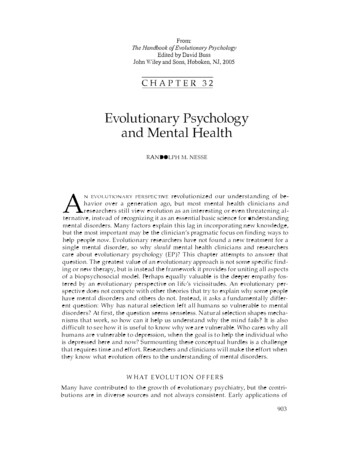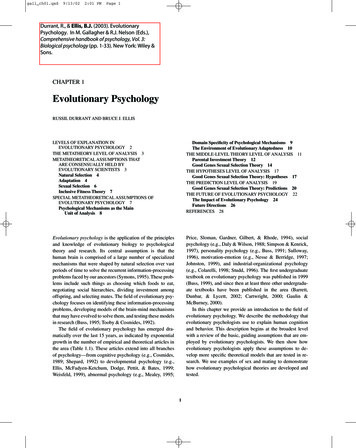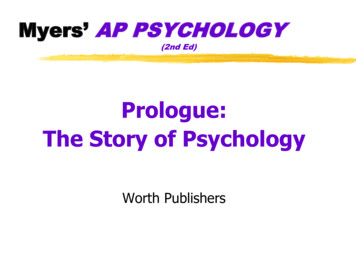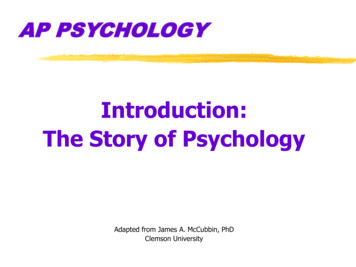
Transcription
From:The Handbook ofEvolutionary PsychologyEdited by David BussJolm Wiley and Sons, Hoboken, NJ, 2005CHAPTER32Evolutionary Psychologyand Mental HealthRANDOLPH 1\1. NESSEN EVOLUTJONi\RY PERSPECTIVE revolutionized our understanding of be havior over a generation Jgo, b u t most tnental health clinicians andresearchers stil l view evolution as an interesting or even thr atcning al ternative, instead of recognizing it as an essential basic science for understandingmental di sorders. l'v1any factors explain this lag in incorporating new knowledge,but the n1ost important 1nay be the clinician's pragn1atic focus on finding ways tohelp people nmv. Evolutionary researchers have not found a new treatment for asingle mental disorder, so why should n1ental health clinicians and researcherscare about evolutionary psychology (EP)? This chapter attempts to answer thatquestion. The greatest value of an evolutionary approach is not some specific find ing or ne\v therapy, but is in stead the framework it provides for uniting a l l JSPL'ctsof a biopsychosocial model. Perhaps equa l ly valuable is the deeper empathy fos tered by an evolutionary perspective on l ifl 's vicissitudes. An evolutionary per spective does not con1pctc with other theories that try to explain why some peoplehave ment.1l di orders and others do not. Instead, i L a ks a fundamental ly d i ffer ent question: Why has natural selection left a l l hun1ans so vulnerable to 1nentald isorders? At first, the question seems senseless. Natural selection shapes mecha n isn1s that \vork, so how can it help us understand why the mind fails? It is alsod i fficult to sec how i t is useful to know vvhy we are vulnerable. Who cares why a l lhumans are vulnerable t o depression, when the goal i s t o help the individual whois depressed here and now? Surmounting these conceptual hurdles is a challengethat requires time and effort. Researchers and cl inicians w i l l n1ake the effort whenthey know ·what evolution offers to the understanding of mental disorders.AWHAT EVOL U T IO N O F F E RSl'v1any ha\'C contributed to the grmv th of evolutionary psychiatry, but the contri butions are in d iverse sources and not ahvays consistent. Early applications of903
904EVOLUTIONJZINC TRADITIONAL DISCIPL I NES OF PSYCHOLOGYTable 32.1Eight Fundamental ContributionsAn evolutionary perspective on mental disorders:1. Asks new questions about why natural selection has left us all vulnerable to mentaldisorders, questions with six kinds of possible answers,2. Offers the beginnings of the kind of functional understanding for mental health professions that physiology provides for the rest of medicine,3. Provides a framework for a deeper and more empathic understanding of individuals,4. Explains how relationships work,5. Provides a way to think clearly about development and the ways that early experiences influence later characteristics,6. Provides a foundation for understanding emotions and their regulation,7. Provides a foundation for a scientific diagnostic system,8. Provides a framework for incorporating multiple causal factors that explain why somepeople get mental disorders while others do not.ethology to mental disorders (McGuire & Fairbanks, 1977; White, 1 '174) gave riseto mort specific and comprehensive evolutionary approaches (McCuin· & Troisi,1998; Pitchford, 2001; Stevens & Price, 1996; Wcncgrat, 1990). Several books coverspecific conditions (Baron-Cohen, 1 99 . 1 997; Cilbert, 1 992; Wcn 'grat, 1995).while others take a more anthropological approach (Fabrcga, 2002). Many articlesaddress specific mt'ntal disorders, and some provide a new found .llion for defin ing the categories that describe disordc'rs (Cosmidcs & Tooby, 1 YY9; Wakefidd,1992). Mony chapters in this Handbook ,md many ,;eneral books about El' tackleone or another mental disorder (Badcock, 2000; Barkow, Cosmidcs, & Tooby, 1992;Barrett, Dunbor, & Lycctt, 2002; Buss, 1994, 1 995, 2003, 2004; Crow ford, Smith, &Krebs, 1 987; Caulin & McBurney, 20ll1 ; Wright, 1 994). The ideas in these sourcesare too 1nany and too diverse to even list, but many can be summ.1rizcd in a list ofeight fundamental contributions that an evolutionary pcrspectiH' offers to psy chiatry and clinical psychology (Table 32.1 ) A brid summary uf c-.1ch sl'ls thestage for considL·ring specific disorders.EXPLAJNJNG VULf\.'EHABl!JTY TO M t·: N TAL O! ORDERSThe task of explaining why \Ve are vulnerable to mental disorders is no differentfrom that of explaining why we arc vulnerable to physical diseases. Tht' tendencyin both cases l1as been to oversimplify the problc1n by attributing v ulnerability tothe limited powers of natural selection. ThesE' limits are important expl.1n,1tionsfor some disl'ases, but there arc five other posslblc reasons thut tlw body andmind are not better designed, starting with the mismatch bchvccn our bodies ,1ndour environments (Nessc & Willi Jms, 1 994; Willia1ns & Ncsse, 1991).Mismatch Most common chronic diseases arc caused by novel cnvironn1cntcdfactors. For instance, atherosclerosis and breast cancer arc prcv 1knt now be cause our bod ics are not \veil dcsign(: d for life in l xnodcrn en\' ironnwnt (Eatonet al., 2002). Whether rates of mental disorders are also increasing remains un certain. An internationzd effort to gather prevalt'llet' data on mental disordersfrmn 72,000 interviews in 1-l countrh s (Kessler & Ustun, 2000) uses urban or
Evolutionary Pst;clzologt; and Mental Health905rural agricultural sites. No con1parable effort is estilnating d isorder rates i nhunter-gatherer populations. This i s unfortunate because such studies m a y notbe possible in the next generation, but understandable because o f the method ological obstacles.Mental d i orders are often blamed on the modern environment. When readingand writing vverc first -spreading, Burton at tributed n1clancholy to excessivestudy and "too little Venus" ( Burton, 1624/1911 ) . Much more recentlv, retrospec tive data seemed to suggest th,lt depression rates were increasing r,1pidly witheach generation (Cross-Na tional Collaborah\re Croup, 1 992). l--fo-wever, data gath ered using consistent questions in the same population over n'cent decadesshowl'd no such increase (J. M. lvfurphy, Laird, fv'lonsun, Sobol, & Leightun, 2000).For drug 1nd a l cohol problems, the story is more clL'ar-cut. The rapid spread o fi!lcohol-making technology ch,1nged our \Vorld i n \vays o u r species has n o t yetadapted to (Institute of Medicine, 1987), although selection n1ay have increasedthe frequency of a defective aldehyde dehydrogenase gene Lhat may protect Asianpopulations from alcoholism (M. Smith, 1986).Infection and Coevolution Infections persist because our every evolutionary nd vance to escape bacteria and viruses is mEJtched by their Ln faster evolution(A . S. Brown ct a l . , 2004; Ewald, 1 994). Furthermore, the ddcnses that protectus, espt' c i a l l y in1mune responses, tend to cause problen1s t hen1sclves. Somemen t a l d isorders mi!y resu 1t from arms races 1.vith pathogens and their Juto i rnnTune :-;equelae. For instance, some cases of obsessive-compulsive disordern1ay result fn}m streptococcal-induced autoimmune dan1agc to t11e caudate nu cleus (S\-vcdo, l.eonard, & Kie sling, Fl94). Prena tal exposure to infection n1aypred i.:-;pose to schizophrenia (lxdgL rwood, Ewald, & Cochran, 200:1) cls sug gested by inc re lsed rates of schizophrenio in babies born during influenza epi delnics ( Kunugi e t a l., 1995) 1nd a sevenfold risk increase for babies born tomotl1ers who had influenza during tlw first trinwstcr (A. S. Brown ct al., 2004).Infectious causes h ;we been proposed for a wide range o f nwntal disordt'rs, es p ec i a l l y a f fe c tive disorders (Ewilld, 2000).A mort' insid ious resul t of rapid coevolution arises fron1 con1petition withinour species that induces more and mon' t xtreme traits, especially thosl' th 1t leadto winning social con1pcti tions (A ll'x,1ndcr, 197-!-; Humphrey, 1 976; Whiten &Byrne, 1 997). I f sexual select ion has shaped mental traits ( M i ller, 2000), this couldaccount for vulnerabil i t y to certain disorders, espl'cia l l y thuse associated withcreativity ( R ich8rds, Kinner, Lunde, & Bt'net, 19.S8; ShanL'r, M i ller, & Mintz,2004). Even aside from cmnpcting for p 1rtncrs, competing for status absorbs vasthuman energy ( Bj]rkow, 1989; Veblen, UN9) and gives rise to much suffL-ring fromcn1.Ty and the ncgntlve emotions associ;1ted with f 1ilures (Gilbert, Price, & /\Ilen,1995). Such emotional tendt'ncies might well result from arms races that oftenl cmTe us in zero-sum competitions ( Fr(]nk, lSJ99).Tmde-0/} s Design trc1de-offs makL' pcrft ction in1possible for any trajt, natural orhun1an n1ade. A car tha t gets 60 m i les pt'r ga l lon w i l l not get to hO mi lt's per hourin 6 seconds. Wt' humans could run faster i f our legs were longt r, but our bonesvvould be Inon fr 1gile. \Ve could han:' lt ss anx iety, but only a t the cost of beingmore l ikt'l.Y to be injured or killed.
906EvoLuT rONIZJNG TRADITIONAL DrsC!PUNES oF PsvcHoLocvConstraints Systen1s shaped by natural selection are subject to several specialconstraints, especially path dependence. For instance, we are stuck with eyes'".rhose vessels and nerves run between the light and the retina. Fu r thern1ore, incontrast to consciously created designs, biological designs are products of selec tion that involve lilnited options, random effects, inaccu rate tran smission of theDNA code, and the vagaries of intPraction effpcts with difft rent environments.Far from a.:-1suming that everything it'i adaptive, an evolutionary approach cal ls at ten tion to defective and substandard designs that result from multiple trade-offs,constraints, and errors.SelccUon Is for Reproductive Success, Not Health Many imagine that selectionshapes bodies zmd minds that arc healthy, long-lived, and coopcratiVl'. I t does,wl1E'n those traits increase reproductive SUCCC'SS (RS). HowenT, cl gene that de creases health, longevity, or coopl'rativeness \vill nonetheless spread if it in creases RS. Such genes are likely responsible for many of ou r least valuedcharacteristics, such as bitter competition, envy/ greed, and unqut·nchable sexualdesire and jealousy ( Buss, 2000). The djfferl'nces between the seAL'S arise largelybecause different reproductive stratE'gics shape different physic1l and n1cntaltraits, even at the expense of longevity and individual wel l-being: (C ronin, 199 1 ;Daly & Wilson, 1 983; Geary, 1 998; Kruger & Ncsse, 2004).Pain, cough, fever, and other protective responses are unpleasant butuseful responses that protect us from dangl'r and loss. The prevalent tendency toconfuse these defenses with disease's Jnd defects has been called "The Clinician'sll lusion" ( Ncsse & Williams, J994). Most physicians knmv that cough and infldm mation are adaptations, but the utility of fl'\rcr, diarrhea, and anxiety is less widelyrccoh:rnized. A naYve view sues our vulnerJbility to neg;1tive emotions as examplesof poor design. But notural selection does not care 1 fig for our happiness; it justmindkssly shapes whatever emotional tcndenciL'S incrc'ase RS ( Nessc, 1 991n;Tooby & Cosmides, 1990). While positive emotions are useful in situations whefl'energy and risk-taking pay off ( Fredrickson, 1 998), they ciln be fataJ in dangeroussituations ( N cssc, 2004).Dcfcn::;csSumming Up Six Causes Smne evolutionary approaches to mental disorders em phasize one of the preceding six possible explan ltions. For instance, some au thors attribute much psychopathology to living in a modern environment (Clantz& Pearce, 1989); others e mphasize infection (Ewald, 2000), constraints, tradc-offs,or poth dependencies (Crow, 1997; Horrobin, 199K). Others propose thot mentaldisordL'rs persist because of fitness benefits, even for conditions such as schizo phrenia (J. S. A l len & Sarich, 1988; Shaner et o l., 2004), bipolar disorder (Wilson,1998), and suicide (dcCatanzaro, 1900). The resulting confusion is substantial forthose in the field and overwhelming for others.\.Vhik the hu m;:m mind prefers monoc us;:d explanntions, a full evolutionaryexplanation for onl' disorder may include scVL'ral different factors. For l'xamplc,vuhwrability to depression may CJrisc from novel aspects of modern life, fron1 in fection, from constraints and trade-offs/ zmd because lcnv n1ood may be a defensethat can increase RS at the expense of }Wrsonal happiness. Par frnm offering a
Evolutionary Psychology and Mental Health907silnplistic approach to the causes of mental disorders, an evolutionary perspectiveprovides a framework for organizing the genuine complexity into a biopsychoso cial perspective (Weiner, 1998).AN EVOLUTIONARY FRAMEWORK FOR UNDERSTANDING HUMANBEHAVIOR AND EMOTIONSWhen a patient comes to the gl'neral 1nedical clinic with cough or kidney failure,the physician knows that cough is a protective response and that the kidney fil ters out toxins and rq;ulates salt and \Vater babncc. By contr,lst, when a p ltientcomes to a mental health clinic ·with a phobia, the utility of anxiety may never beconsidl'rcd. VVhen someone conws with jealousy, consideration of its normal func tions is unlikdy. Mental health profession Jls l 1ck 1 body of knowledge about nor mal emotional functions comparable to the understanding physiology offers togeneral medicine. EF is beginning to provide this missing body of knowlcdgC', asshmvn by tlw chapters in this 1-landbook, and by evolutionary perspectives on mo tivation (French, Kamil, & Leger, 2000), emotion (Plutchik, 2003), and specifictopics such as grid (Archer, 19Y9).U NLJEHSTAND!NC I0.iDIV!UUAL L Jv J:sEP can bring information about an individual's idiosyncratic values, goals, andlife situations into a scientific framework. Consider John, a dt pressed 20-year-oldman \Vho \vorks two jobs in local stores to support his disabled metlwr.-Whcn hevvc1s 14, his dying father made him promise to t .1kc care of his mother always. Hehas been doing th Jt ever since, but with increasing resentment and depression.These three sentt nces give more insight into his depret'ision than a dozen derno gr lphic variables and a brain scan. An evolutionary understanding of motivationcan begin to bring such inform ltion into a nomothetic fraJnC'work based on bc haviural ecology categories of life history effort. Tlw tradc-offs among these catc gorh.'s are as universal as tlwy arc problL'mc1tic (Krebs & Davies, 1984; Stearns,1992). No solution can be perfect, and tht' conflicts account for much human suf fering (Chisholm, 1999; Low, 2000; E. A. Smith & Wintcrhalder, 1992; Sterelny &Griffiths, 1999). UndL'rstanding these tradc-offs fosters realistic clinical thinking 1nd enhances empathy for the vicissitudes of people's lives.REL;\TJC)NS!-!JPSEP's greatest contribution may be a deeper understanding of rebtionships.For instance, Bmvlby's (1969) insights about the evolutionary functions of attach ment have been extended by suggestions that apparently "abnormal" kinds of at tachnwnt may represent alternativL' strategies for infants to get resources fron1mothL'rs in difficult circumstances (Belsky, ]999; Chisholm, 1Y96) and a deeperunderstanding of women's n'productive stratt. gies in gerwral (Hrdy, 1999).Analysis of mutually beneficial re-ciprocal exchanges has led to extensive studit sof econmnic games (Fchr & Fischbaclwr, 2003) that illuminate the origins ofthe social en1otions (Fessler, in press; Fiske, 1992; Henrich & Cil-Whitc, 2001).Hmve\'tT, interpreting all human relationships as calcubtc d exchanges ignores
908EvotunoNJZING TRADITIONAL DiSCIPLINES oF PsYCHOLOGYaspects of human behavior that are essential to understanding n1ental disorders,such as our capacities for moral action and the emotions of pride and guilt (Katz,2000). Selection n1ay have shaped capacities for conunitment that are superior torational calculation (Frank, 1988; Gintis, 2000; Nesse, 2001a).Freud's theories are ridiculed because some are wrong and be cause psychoanalysis is not reliably effective. However, the reality of repression isa profound fact of human nature that needs an evolutionary explanation (Bad cock, 1988; Sulloway, 1985), along with phenomena such as the Oedipus complex!Ericson, 1993). Trivers and Alexander separately suggested that self-deception isa strategy for deceiving others (Alexander, 1975; Trivers, 1976, 2000), but peoplealso may repress the sins of others to preserve valuable rC'Iationships (Nesse,1990b). Closely related is Trivers's (1974) insight that regression may be an effec tive strategy used by offspring to manipulate their parents into providing re sources that would be appropriate only if they were younger or sick. His moregeneral theory of parent-offspring conflict is the neglected foundation for under standing many childhood disorders. Attempts to provide an evolutionary founda tion for psychodynamics are developing (Badcock, 1988; Slavin & Kriegman, 1992;Sulloway, 1985) but remain relatively unappreciated by psychoanalysts, perhapsbecause an evolutionary view fosters skepticisn1 that undermining repressionwill be helpful routinely (Slavin & Kriegman, 1990).PsychodynamicsDevelopment Developmental psychology now offers sophisticated assessments ofextensive data about what children do at different stages of life and how thesephenon1ena vary across cultures. It increasingly takes evolution into account(Bateson & Martin, 2000; Geary & Bjorklund , 2000; Rutter & Rutter, 1993). In themidst of a burst of interest in facultative developmental mechanisn1s and theirrole in evolution (Hall, 1998; West-Eberhard, 2003), evolutionary psychologistshave begun looking for mechanistns that use environment inputs to adjust devel opmental pathways. An obvious facultative adaptation is the regulation of femalereproductive onset by fat stores (Surbey, 1987). Less well supported are proposalsthat early father absence induces early reproduction (Belsky, Steinberg, & Draper,1991; Draper & Harpending, 1982; Surbey, 1990). A possible adaptation with par ticular relevance for mental disorders is the adjustment of the gain in the hypo thalamic pituitary axis system in response to early stress and the transmission ofthis sensitivity across the generations by maternal influences on fetal brain de velopment (Essex, Klein, Eunsuk, & Kalin, 2002; Teicher et a!., 2003).EMOTIONS A ND T H E ElVIOTIONAL D ISORDERSMost mental disorders are emotional disorders. People come for treatment be cause they experience anxiety, deprl'Ssion, anger, or jealousy. Many assume thatsuch negative emotions are abnormal, but they are usefut at least for our genes.People with depression and anxiety are so obviously impaired that it is difficultto see how such emotions could be useful. However, selection has shaped emo tion regulation mechanisms that often give rise to normal but useless suffering(Nesse, 2004, 2005). An evolutionary foundation for studies of emotions is nowroutine (Ekman, 1992; Nesse, 1990a; Plutchik, 2003; Tooby & Cosmides, 1990) and
Evolutionary Psychology and Mental Health909recognition is growing that en1otions are special states shaped by selection togive advantages in fitness-significant situations that have recurred over evolu tionary tilne.OJ/\CNOSISWhen is an e1notion abnonnal? The criteria for psychiatric diagnoses are based onintensity, dur.:Jtion, and associated disability (American Psychiatric Association,]994). The extremes are abnormal, but without knmving the functions of emo tions, the line between normal and abnormal re1nains subjective (D. Murphy &Stich, 2000; Ncsse, 2001b; Troisi & McGuire, 2002; Wakefield, 1992). The lack of anevolutionary foundation fosters serious errors including describing continuousemotions as categories and neglecting abnormal conditions characterized by ex cess positive or deficient neg ltive enwtions. Jn addition, diagnostic criteria do notconsider the appropriateness of an emotion to the situation. If general nwdicincn1ade diagnoses according to the strategy used in psychiatry, it would diagnoseabnormal cough disorder based on cough frequency and severity without consid ering \Vhcther the cough \va;.; a norma] response in certain situations. Far fromgenuine] y atlworetical, the Diag1wstic and Stati tical Mmwal ( f Mental Disorders sys tL'l11 (DSi\1; A1nerican Psychi,1tric Association, J994) fosters a crudt' biologicalview (Horwitz, 2002).Many agree that the DSM system inhibits understanding (Phillips, First, & Pin cus, 2003), and several authors have suggested hmv evolutionary principles can helpto m,1kc diagnosPs more scientific. D. Murphy and Stich (2000) take}he DSM to taskfor its atheoretical approach and suggest distinguishing disorders that arise frombrain abnormalities from those that arise from normal brains exposed to novd C'nvi ronmcnts. Tlwy propose categories based on the presumed modularity of cognitivedesign. VVakefield (1992) offers a strong critique of the DSM, using tlw concept of"harmful dysfunction" to clarify what is and is not a disorder. This sophisticatL·devolutionary analysis of psychiatric diagnosis argues that it is essentiJ.l for mental aswell as physical disorders to separate normcll from abnormal phenomena based onwhether thl'y arc h umful and whether tlwy arise from a dysfunction. This sophisti cated understanding of evolutionary function is the scientific foundation for futurepsychi 1tric diagnostic systems (Wakefield, this volume).An C\'olution,uy view highlights the central flJw in the DSM criteria; they donot rcfll'ct the most basic distinction in medical diagnosis: that between diseasesand symptoms of diseases. Negative emotions such as anxiety and sadness cueuseful ciJpacitics shaped by natural selection. Determining \Vhen they are abnor mal requirL'S undt rstanding when 1nd hmv they are u eful.An approach based on Darwinian medicine, following Wakefield, suggestsglobal cakgories of mental problems based on ansv T·rs to three questions: ( 1 ) Arecognitive and brain mc'chanisn1s normal or defective? (2) Do the symptoms arisefrmn non'I aspects of the environment, lnd (3) Are the symptmns in the interestsof the individual, his or her genes, or neither? The rC'sulting categories are:1 . Emotional, cognitive, or behavioral responses that arise from normal systl'lns:a. Useful responses that miJy be a\'ersivc (ordinary anxiety and anger).b. Normal responses that bl'ncfit the indiv idual's gcnl's, at the expense ofthe individual's interests.
910EvoLUTlONIZING TRADJTTONAL D rscrrLTNES oF PsYCHOLOGYc. Responses that arise from norn1al system b u t that are not useful in theparticular instance.d . Nonnal responses that are useless or harmful now but would not havebeen in the ancestral environment.e. Normal responses that do not harm the individua I b u t that are defined asabnormal by a group or culture.2. Sy1nptoms arising from abnormal regulation of a normal emotion or cap Kity.a . Specific defects, genetic or acquired, account for the dysrcguL1tion (cau sation from below, hardware problems).b . Dysregulation arising from soci;1l dilemmas or complexities (c 1tJSiltionfrom abovL', software problems).c. E x tremes of a trait d i stribution that increJse vulnerability.3. Abnormalities of behavior, cognition, and emotion that arisL' from funda nlental brain or cognitive abnormalities not pri1narily involved vvith systemsthat regulate e motion and behavior (e.g., lead poisoning).INDIVIDUAL DrFFERFNC'ESMost psychiatric research attcn1pts to explain individual differences. Despitegrowing agreement on the importance of gene-environment intcroctions (Kendlcr,Kuhn, & Prescott, 2004; Ridky, 2003; Rutter & Rutter, 1993), m jor disagreenwnlspersist about why some people get i l l and others do not. D ifferent authorities L'm phasize different causal factors (gem,tic, developmental, situational, t tc.). Farfrom emphasizing genetic differences, an evolutionary view provides a framl'\Vorkthat highlights the relationships among a l l fJctors and levels. 1 t also contributesstrategies for avoiding some s i mple n1istakes.Much misunderstanding arises from confusing attempts to expla i n the exis tence of a trait with attempts to explzli n variations in a trait. It is scnsclt ss to askwhetlwr a rectangle is caused 1norc by its length or its w i d th. However, rect,1n gles can vary in area only if thei r width or length (or both) chrmges. Likcw isL ,variutions among individuals can result only from diffl'rc ncf's in gl IWS, differ ences in environments, and the interactions between thcn1. The proportion ofvariance 1ttributablc to each component is not fixed, but varies dl'pL'nding on tlwparticular environment and the range of genotypes. Preoccupation wdh n ltureversus nurture has distracted atkntion from the tnany different routes to J dis order. An evolutionary approach fosters s imultaneous cont idt ration of the m,1nyfc1ctors that may explain i ndividual variation in a trait, some of which lrc listed inTable 32.2.The task of accounting for individual differences should not bL' reduced to tr guing about the relative importancl' of one factor compared tu another. It is,instead, the challenge of explicating how each contributes to individual diffl'r e ncl's in a particular trait and how their contributions to a particuLn trait m;1ybe different not only between families, populations, or cultures, b u t even be t'\Vel'n indiv iduals. The responsible factors may be mainly genetic in one i ndi vidual and tnainly environmental in another. This has practical implic,ltions formentol health research. For instance, we need to take SL'riously the possibilitythat 1nany different genes contribute to depression v u l nerability by many d if ferent routes.
Evolutionary Psychology and Mental Health911Table 32.2Twelve Sources of Individual Differences1. Additive genetic differences among individuals that result in phenotypic differences(in this environment)2. Variation resulting from Gene x Environment interactions3. Variation resulting from Gene x Gene interactions4. Assortative mating-nonrandom mating increases or decreases trait variance5. Random factors in development, such as the stochastic paths of neuron migration6. Effects of cues that influence development via facultative mechanisms to a trajec tory suited to the particular environment, such as early heat exposure influencingthe number of adult sweat glands7. Effects of trauma, toxins, and other environmental exposures outside the range ofnormal that damage the organism or distort its development8. Effects of environmental factors that influence the organism "top down" via percep tual experience without resulting in damage or acting via a specific facultativemechanism9. Effects of environmental factors that influence the organism from the "bottom-up"that are neither damaging nor mediated via facultative adaptations10. Effects of individual learning that facilitate flexible coping with current aspects ofthe environment11.Experiences shared within a culture that are incorporated into values and emotionalproclivities that may be difficult to change later (such as values or sexual attitudes)12. Experiences shared within a culture whose effects account for variation thatchanges readily when conditions changeSPECIFIC DISORDERSAn evolutionary perspective calls attention to a distinction that is fundamentaland well recognized in 1nost of medicine, but unaccountably neglected in psychi atry. Son1e 1nedical conditions, such as cancer and epilepsy, are diseases that arisefrom some abnormality in the body's mechanisms, while others, such as pain andcough, are protective responses. Some mental disorders, such as schizophreniaand autism, are allnost certainly specific diseases or clusters of diseases, whileothers, such as depression and panic disorder are fundamentally different in thatthey are useful protective mechanisn1s, albeit ones that readily go awry. Not allmental disorders are c1notional disorders, but n1any are, and they deserve consid eration together.EMOTIONAL D ISORDERSMost mental disorders are emotional disorders, but they are not yet based onknowledge about the origins and functions of emotions. Instead, intense or pro longed negative emotions are said to be abnormal, irrespective of the situation,while deficits in negative emotions and excesses of positive emotions are rarely rec ognized as disorders. An evolutionary perspective provides a n1ore balanced view.Although anxiety can be usefut a dry mouth and tre1norwhen standing before a large group seem worse than ust:'1ess. Likewise, thesymptoms of panic may help escape fron1 a lion, but they are unhelpful in a gro cery store. We novv have a vast amount of knowledge about the responsible brainAnxiety Disorders
912EvoLUTIONlZ!NG TRADITIONAL DJSCJPLTNES or PsYCHOLOGYn1echanisms, but no comparable body of knowledge about the evolutionary ori gins and utility of social anxiety or panic (Nesse, 1987). Similarly, hundreds ofstudies document every aspect of excessive anxiety states, but only a handfullook for states of deficient anxiety, the hypophobias (Marks & Nesse, 1994). Onestudy tried to confirm that fear of heigbts often results from severe falls early inlife. It found adult fC'ar of heights in 18%) of the control group but only 3% of thegroup that had experiL'nced a fall early in life. Those \" 'ith hypophobia early inlife still had deficient anxiety decades later (Poulton, Davies, Menzies, Langley, &Siha, 1998).Anxiety illustrc1tes the diversity of the body's regulation mechanisn1s (Barlow,, 1 9H8; Marks, 1987; Poulton & Menzies, 2002; Stein & Bouwer, 1997). For instance,rigid defensive responses to fixed cues, such as chicks hiding from hawk-shapedshadows, are useful when a correct response to the first encounter is esscntiatbut they n:sult in many false alarms and do not protect against novel dangers.Fll'xible learning mechanisms protect against novel c
An evolutionary perspective on mental disorders: 1. Asks new questions about why natural selection has left us all vulnerable to mental disorders, questions with six kinds of possible answers, 2. Offers the beginnings of the kind of functional understanding for mental health pro-fessi










